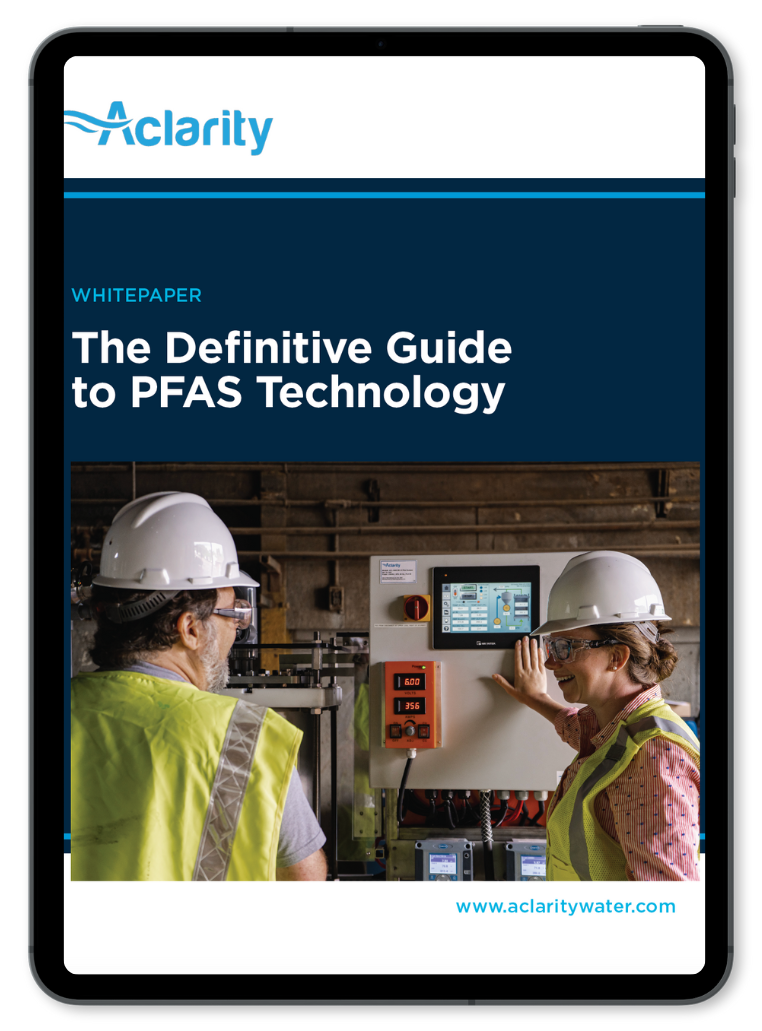How to Identify and Remove PFAS in Wastewater
May 16, 2024 | 6 minute read

PFAS have raised public health concerns due to their presence in waterways, leading to stringent regulations and a focus on their removal from wastewater. The U.S. EPA has responded by setting limits on PFAS in drinking water and designating certain types as hazardous substances, with a focus on accountability and the development of new testing methods like Method 1633 for detecting PFAS in environmental samples.
It’s safe to say that alarm bells are now ringing for public health when it comes to per and poly-fluoroalkyl substances (PFAS). With recent regulations and announcements calling out PFOA and PFOS, these two compounds are having a high level of scrutiny.
PFAS are chemicals that enable companies to make coatings and products that are heat, oil and grease, stain, and water resistant. They show up in everyday products, including clothing, furniture and carpets, packaging (pizza boxes, for example), cookware, cosmetics, electronics, and more. However, their versatility comes with a toll on our health and our environment.
The presence of PFAS has reached a tipping point and all eyes are now on the solutions. But first, let’s explore how to identify PFAS and then remove it from wastewater.
EPA Sets National Standards for PFAS in Drinking Water and Classifies Them as Hazardous
The U.S. Environmental Protection Agency (EPA) has taken decisive action by placing national limits on PFAS in drinking water and designating PFAS as a hazardous substance.
New EPA rules introduce robust health safeguards and mandates public water systems to actively monitor and diminish PFAS levels in drinking water. This groundbreaking initiative is projected to mitigate PFAS exposure for an estimated 100 million people, effectively curbing thousands of serious illnesses.
The EPA has also designated two types of PFAS as hazardous substances, a long-awaited move meant to hold polluters accountable. The agency is targeting these chemicals under the Comprehensive Environmental Response, Compensation and Liability Act, known as CERCLA or Superfund. The agency also released updated interim guidance on PFAS destruction and disposal through a range of technologies.
How Can Industrial Sites and Landfills Test for PFAS?
Before we can tackle the issue of PFAS contamination, we must first detect its existence. Testing methods play a crucial role in determining how to eradicate PFAS.
The EPA’s Office of Water and the Department of Defense’s (DoD) Strategic Environmental Research and Development Program have published Method 1633 to test for PFAS. The method can now be used by laboratories, regulatory authorities, and others for the analysis of 40 PFAS compounds in wastewater, surface water, groundwater, soil, biosolids, sediment, landfill leachate, and fish tissue.
The EPA encourages the adoption of this method while acknowledging the potential for revisions during future rulemaking processes. This method represents a crucial advancement in the ability to detect and monitor PFAS contamination, facilitating informed decision-making and effective environmental management.
Some solution providers also offer site testing at wastewater facilities and landfills. You want to be sure their lab adheres to state mandates, methods, detection limits, and sampling guidelines. PFAS destruction technologies like Aclarity offer a site test so you can quickly gauge the power of its electrochemical oxidation (EOx) system and zero in on how it can help your facility.
How Can PFAS Be Remediated Once It is Found in Industrial Wastewater or Landfill Leachate?
Once PFAS is identified, the next step is clear: removal or destruction.
However, navigating the removal route requires careful consideration of available technologies and treatment strategies. Each approach offers its own set of advantages and limitations, making it essential to tailor the solution to the specific needs of the site.
The waste and recycling industry has been weighing the pros and cons of removal vs. destruction strategies for some time. Removal offers partial respite, but destruction is a comprehensive solution and the only clear path to a future that does not include PFAS. (add link to one of our past blogs that give overview of technologies).

The Definitive Guide to PFAS Technology Whitepaper
Comprehensive guide to understanding PFAS management strategies to reduce risk and safeguard environmental and public health.
Stay current on advantages and disadvantages of technologies available for PFAS:
- Removal
- Disposal
- Destruction
Who Can Help with PFAS Destruction?
Aclarity’s innovative solutions are revolutionizing the landscape of PFAS remediation.
Its low energy PFAS destruction technology can be implemented onsite to help ensure that PFAS is destroyed as soon as possible.
This allows landfills and facilities to attack these stubborn ‘forever chemicals’ at the source before they migrate elsewhere.
While separation and disposal of leachate by conventional methods can carry excessive costs and risks, Aclarity's solution destroys PFAS forever, breaking the PFAS cycle back to the environment.
The Path Forward for PFAS in Wastewater
What started as a what-if scenario has now turned into a must-do for the solid waste, recycling, industrial manufacturers and wastewater industries when it comes to recognizing and tackling PFAS.
The recent mandates out of D.C. have accelerated the timelines affecting these facilities and there’s no looking back.
In addition to the necessity of complying with the new laws and regulations, addressing PFAS is a matter of protecting our own families and communities.
The bottom line is that we are all tasked with the monumental undertaking of removing PFAS from wastewater to safeguard public health and environmental integrity. With an innovative company like Aclarity leading the charge, the path ahead may be challenging, but it's one we are more than equipped to navigate.
Sources:
https://www.eenews.net/articles/epa-to-scrutinize-forever-chemicals-in-wastewater-sewage/
Nature is better off without PFAS. And so is your business.

The future of waste management starts now. Destruction beats disposal so we created an on-site solution that puts an end to PFAS for good. When our EOx process meets forever chemicals, the environment is not the only winner. Get a free evaluation for your PFAS destruction needs today.
